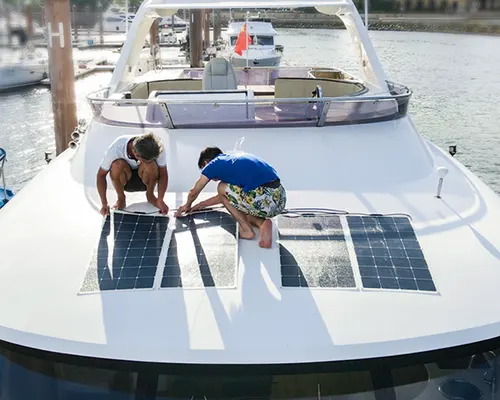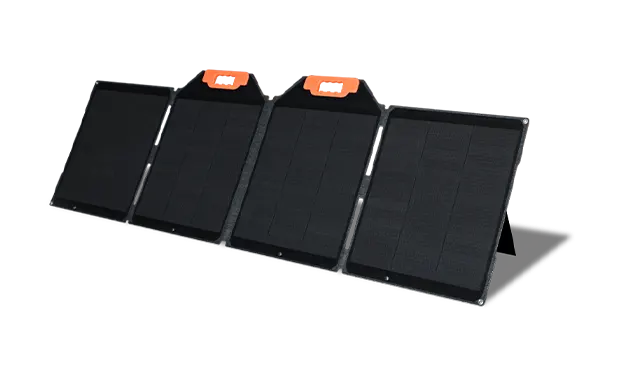What Size Solar Battery Charger for Boat Need?
Having a reliable solar battery charger for your boat is crucial for powering your onboard electronics. Whether you’re out sailing, fishing, or cruising on the lake, an efficient and easy-to-use solar charger is essential. Learn what size solar battery charger you need for your boat. In this guide, we break down how to choose the right Solar Battery Charger for Boat based on your boat needs, ensuring that your onboard electronics always have a stable power supply.

Types of Solar Battery Chargers for Boats
Given the variety of batteries on the market, the choice of solar battery charger can significantly impact your boat’s performance. Selecting the right charger is vital. Here are three of the most commonly used types of solar battery chargers, tailored to different needs:
1. Trickle Charging
Trickle charging is the most common type of marine solar battery charger. It is often used for low-power boats due to its slow charging speed and lower power output. Trickle chargers are ideal for maintaining a boat’s battery when it’s anchored and can function in both sunny and cloudy conditions. The key advantage of trickle chargers is their simplicity; they don’t require any additional equipment or wiring, as they connect directly to the boat’s electrical system.
2. Light-Use Charging
These chargers are typically small, lightweight, and easy to carry on board. They are perfect for charging smaller electronic devices such as mobile phones, tablets, and cameras.
3. High-Power Charging
High-power chargers are suitable for boats that require substantial power, such as luxury yachts equipped with TVs, coffee machines, and other high-demand appliances. These chargers provide a higher current than light-use chargers, allowing for quick recharges after periods of heavy use. However, they typically require additional equipment and wiring. Modern solar generators are becoming popular in this category, offering high power output with the added benefits of being noise-free and user-friendly.

What You Need For a Solar Battery Charger For Boat?
Understanding the types of chargers is only part of the equation. You also need the right components to ensure smooth operation. Here’s what you’ll need:
Solar Panels
Solar panels are the cornerstone of a solar battery charging system. They convert sunlight into electrical energy, which is then stored in your battery. The efficiency of your solar panels will directly impact the charging speed and effectiveness. Therefore, selecting high-quality solar panels is crucial.
For example, the Sungold BXF Series 200W Portable Photovoltaic Panel is an excellent option. It features a foldable design for easy portability, making it ideal for boating, RVs, and camping. With an efficiency of 22.7% thanks to advanced shingled cell technology, it provides stable and long-lasting power. Its IP68 waterproof rating ensures safety in all weather conditions, and it offers three charging ports to support a variety of devices, including small power storage units and laptops. The panel delivers 200W of power, ensuring fast and efficient charging during your outdoor adventures.

What Can a 200W Solar Panel Run?
A 200W solar panel can power small appliances such as smartphones and laptops. While it produces less energy than a 300W panel, it is well-suited for charging smaller devices that don’t require continuous power.
Now,
Battery Amperage:
Power Required = V x I
(We will use a conventional 12V battery)
80 = 12 x I
I = 6.67 = 7A (approx.)
Battery Capacity (AH):
= Load x Backup Time / Battery Voltage
= 80 x 10 / 12 (Backup Time is 10 hours)
= 66.7 = 70 AH
Now, Battery Charging Current t = 1/10 of Battery Size
= 1/10 x 70 = 7A
Solar Panel Required Current = Battery Amperage + Battery Charging Current
= 7+7 = 14A
Now, using the formula; P = V x I
Solar Panel Wattage,
= 15 X 14 (Solar Panel Average Voltage is 15V)
= 210 Watts
You will need a total of 210 Watts of solar panels.
How Many Amps Can a 200W Solar Panel Produce?
Amperage measures the electromagnetic force between electrical conductors carrying current. A 200W solar panel typically produces 5-6 amps per peak sunlight hour. With 6 hours of direct sunlight, you can expect to generate about 30-36 amps per day.
Several factors, such as weather conditions and solar panel orientation, affect amperage. On cloudy days, or if the panels are not optimally positioned, the amperage will be lower. Generally, 200 Watts is roughly equivalent to 0.833 amps.
Note: Solar panels typically produce between 50-100% of their maximum rated current value under normal conditions.
FAQs Solar Battery Charger for Boats
1. What size solar battery charger do I need for my boat?
The size of the solar battery charger you need depends on your boat’s power requirements and the devices you intend to charge. Calculate your total power needs by considering all onboard electronics and appliances, and choose a charger that can provide adequate power based on those needs.
2. Can a solar battery charger fully power my boat?
While a solar battery charger can maintain and extend the life of your boat’s batteries, it may not be sufficient to power all of your boat’s systems, especially for larger boats with high energy demands. It’s best used as a supplementary power source.
3. How do I install a solar battery charger on my boat?
Installation typically involves mounting the solar panels in a location with maximum sun exposure, connecting the charger to your boat’s battery system, and ensuring proper wiring. Depending on the complexity, you may want to consult a professional.
4. Is a 200W solar panels for boats?
A 200W solar panel can power small devices like smartphones, laptops, and even small refrigerators, depending on usage. However, for larger systems, you may need additional panels to meet your energy needs.
5. Will a solar battery charger work on cloudy days?
Yes, solar battery chargers can still work on cloudy days, but their efficiency will be reduced. It’s essential to position the solar panels to capture as much sunlight as possible.
6. Can I use a solar battery charger while my boat is in use?
Yes, you can use a solar battery charger while your boat is in use. It helps maintain battery levels and provides power to onboard electronics.
7. How do I maintain a solar battery charger for boat?
Regular maintenance involves cleaning the solar panels to ensure they are free from debris and checking the connections and wiring for any signs of wear or damage.
8. Can a solar battery charger overcharge my boat’s battery?
To prevent overcharging, many solar battery chargers come with a built-in charge controller, which regulates the charging process and ensures your battery stays within safe limits.











